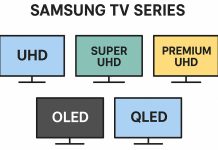In 2021, LG introduced its new Evo OLED displays. The company claims that this technology enhances user experience and improves image quality, though this is a broad overview. In this article, we will discuss how this technology differs from previous OLED screens. Essentially, LG has utilized advancements in materials and technical improvements to create a new generation of OLED displays.
Why Are LG’s New OLED Evo Displays Better Than Standard OLED?
The main advantage of LG’s new OLED Evo screens is their increased brightness. While traditional OLED panels typically offer around 800 nits, the OLED Evo displays push that up by approximately 20%, reaching up to 1000 nits. This makes the image much clearer in bright rooms and significantly enhances HDR performance.
Making a display brighter isn’t especially complex in theory: the higher the voltage, the brighter the pixels. But OLED panels use organic materials, which degrade faster under high voltage. So the real challenge is finding the right balance between brightness and longevity.
LG tackled this by switching to new OLED materials from DuPont, moving away from their previous supplier, the Japanese company Idemitsu. After a year of testing, LG found DuPont’s materials to offer better performance and long-term potential. DuPont solved this problem by using heavy hydrogen, deuterium, instead of regular hydrogen. This helped the company to increase the lifetime of blue OLED elements and allowed it to supply them with higher voltages. This, in turn, allowed LG to create Evo OLED displays with higher brightness.
Another key innovation is the integration of micromirrors near the pixels. Normally, some light inside the panel gets scattered or absorbed, reducing overall brightness. These micromirrors redirect that light outward, effectively boosting brightness without increasing power consumption.
Older OLED screens often suffered from color shifts over time, especially a reddish tint. This was caused by the faster aging of blue OLED materials, which have the shortest lifespan. The updated materials and design in OLED Evo panels help mitigate this issue as well.
In short, OLED Evo isn’t just brighter — it’s a smarter, more efficient technology that improves picture quality while preserving screen durability.
LG TVs with OLED Evo Displays
LG first unveiled its WG1 series OLED Evo TVs at CES 20, and now most of LG’s OLED TVs feature OLED Evo displays, with the A-series being the only lineup that still uses the previous generation panels.
While there is no official confirmation that other manufacturers such as Sony or Panasonic are using OLED Evo panels, it is conceivable that some competing brands may be receiving similar upgraded panels from LG Display. However, since “OLED Evo” is a trademark owned exclusively by LG Electronics, other brands will not release their TVs under this brand even if they use such panels.








